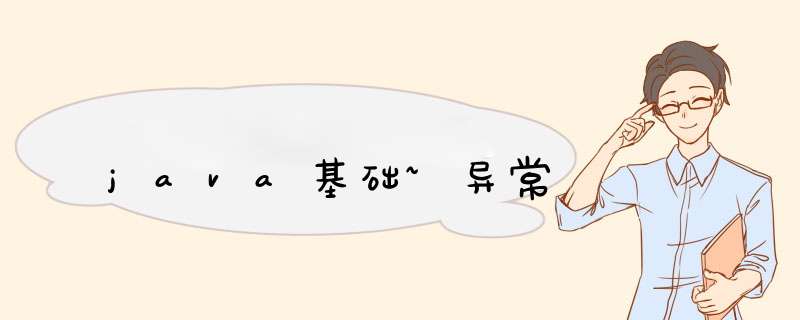
目录
异常概述与异常体系机构
异常概述
异常体系结构
常见异常
运行时异常
编译时异常
异常处理
异常处理方式一: try-catch-finally
异常处理方式二:throws
手动抛出异常: throw
用户自定义异常类
异常总结
异常概述与异常体系机构 异常概述
在使用计算机语言进行项目开发的过程中,即使程序员把代码写得尽善尽美,l在系统的运行过程中仍然会遇到一些问题,因为很多问题不是靠代码能够避免的,比如:客户输入数据的格式,读取文件是否存在,网络是否始终保持通畅等等。
异常概念:在Java语言中,将程序执行中发生的不正常情况称为“异常”。(开发过程中的语法错误和逻辑错误不是异常)
Java程序在执行过程中所发生的异常事件可分为两类:
Error:Java虚拟机无法解决的严重问题。如:JVM系统内部错误、资源耗尽等严重情况。比如:StackOverflowError和OOM。一般不编写针对性的代码进行处理。
public class ErrorTest {
public static void main(String[] args) {
//1.栈溢出:java.lang.StackOverflowError
main(args);//递归主函数调用主函数
}
}
public class ErrorTest {
public static void main(String[] args) {
//2.堆溢出:java.lang.OutOfMemoryError
Integer[] arr = new Integer[1024*1024*1024];
}
}
2.Exception:其它因编程错误或偶然的外在因素导致的一般性问题,可以使用针对性的代码进行处理。例如:
空指针访问
试图读取不存在的文件
网络连接中断
数组角标越界
对于这些错误,一般有两种解决方法:一是遇到错误就终止程序的运行。另一种方法是由程序员在编写程序时,就考虑到错误的检测、错误消息的提示,以及错误的处理。
捕获错误最理想的是在编译期间,但有的错误只有在运行时才会发生。比如:除数为0,数组下标越界等
分类:编译时异常和运行时异常
异常体系结构java.lang.Throwable
java.lang.Error:一般不编写针对性的代码进行处理。
java.lang.Exception:可以进行异常的处理
编译时异常(checked)
IOException
FileNotFoundException
ClassNotFoundException
运行时异常(unchecked,RuntimeException)
NullPointerException(空指针异常)
ArrayIndexOutOfBoundsException(角标越界)
ClassCastException(类型转换异常)
NumberFormatException(不是数字格式异常)
InputMismatchException(输入不匹配异常)
ArithmeticException(数学算数异常)
常见异常 运行时异常空指针异常
//NullPointerException(空指针异常)
@Test
public void test1(){
// int[] arr = null;
// System.out.println(arr[3]);
String str = "abc";
str = null;
System.out.println(str.charAt(0));
}
2.角标越界
//IndexOutOfBoundsException(角标越界)
@Test
public void test2(){
//ArrayIndexOutOfBoundsException
// int[] arr = new int[10];
// System.out.println(arr[10]);
//StringIndexOutOfBoundsException
String str = "abc";
System.out.println(str.charAt(3));
}
3.类型转换异常
//ClassCastException(类型转换异常)
@Test
public void test3(){
Object obj = new Date();
String str = (String)obj;
}
4.不是数字格式异常
//NumberFormatException(不是数字格式异常)
@Test
public void test4(){
String str = "123";
str = "abc";
int num = Integer.parseInt(str);
}
5.输入不匹配异常
//InputMismatchException(输入不匹配异常)
@Test
public void test5(){
Scanner scanner = new Scanner(System.in);
int score = scanner.nextInt();
System.out.println(score);
scanner.close();
}
6.数学算数异常
//ArithmeticException(数学算数异常)
@Test
public void test6(){
int a = 10;
int b = 0;
System.out.println(a / b);
}
编译时异常
@Test
public void test7(){
File file = new File("hello.txt");
FileInputStream fis = new FileInputStream(file);//出现错误
int data = fis.read();//出现错误
while(data != -1){
System.out.print((char)data);
data = fis.read();//出现错误
}
fis.close();//出现错误
}
异常处理
在编写程序时,经常要在可能出现错误的地方加上检测的代码,如进行x/y运算时,要检测分母为0,数据为空,输入的不是数据而是字符等。过多的if-else分支会导致程序的代码加长、臃肿,可读性差。因此采用异常处理机制。
Java采用的异常处理机制,是将异常处理的程序代码集中在一起,与正常的程序代码分开,使得程序简洁、优雅,并易于维护。
Java异常处理的方式:
try-catch-finally(自己可以处理掉的异常)
throws+异常类型(自己搞不定,往上抛)
try{
//可能出现异常的代码
}catch(异常类型1 变量名1){
//处理异常的方式1
}catch(异常类型2 变量名2){
//处理异常的方式2
}catch(异常类型3 变量名3){
//处理异常的方式3
}
....
finally{
//一定会执行的代码
}
异常处理解析:
如下列代码,可能出现异常的代码是
num = Integer.parseInt(str);
所以我们用try把语句包起来,
出现异常的时候会立刻生成一个对应异常(本次异常为NumberFormatException) 类的对象
经过try关键字将异常类的对象抛到catch的参数列表进行异常捕获
类型匹配成功就执行对应catch里的代码
异常成功被处理之后继续执行后面的代码
@Test
public void test1(){
String str = "123";
str = "abc";
try{
num = Integer.parseInt(str);
System.out.println("hello-----1");
}catch(NumberFormatException e){
System.out.println("出现数值转换异常了,不要着急....");
}catch(NullPointerException e){
System.out.println("出现空指针异常了,不要着急....");
}catch(Exception e){
System.out.println("出现异常了,不要着急....");
}
System.out.println("hello-----2");
}
出现数值转换异常了,不要着急....
hello-----2
说明:
finally是可选的。
使用try将可能出现异常代码包装起来,在执行过程中,一旦出现异常,就会生成一个对应异常类的对象,根据此对象的类型,去catch中进行匹配
一旦try中的异常对象匹配到某一个catch时,就进入catch中进行异常的处理。一旦处理完成,就跳出当前的try-catch结构(在没有写finally的情况)。继续执行其后的代码
catch中的异常类型如果没有子父类关系,则谁声明在上,谁声明在下无所谓。
catch中的异常类型如果满足子父类关系,则要求子类一定声明在父类的上面。否则,报错
常用的异常对象处理的方式:
① String getMessage() 获取异常信息
② printStackTrace()获取异常堆栈信息
在try结构中声明的变量,再出了try结构以后,就不能再被调用
try-catch-finally结构可以嵌套
finally的使用:
finally是可选的
finally中声明的是一定会被执行的代码。即使catch中又出现异常了,try中有return语句,catch中有return语句等情况。
像数据库连接、输入输出流、网络编程Socket等资源,JVM是不能自动的回收的,我们需要自己手动的进行资源的释放。此时的资源释放,就需要声明在finally中。
@Test
public void test2(){
FileInputStream fis = null;
try {
File file = new File("hello1.txt");
fis = new FileInputStream(file);
int data = fis.read();
while(data != -1){
System.out.print((char)data);
data = fis.read();
}
} catch (FileNotFoundException e) {
e.printStackTrace();
} catch (IOException e) {
e.printStackTrace();
}finally{
try {
if(fis != null)
fis.close();
} catch (IOException e) {
e.printStackTrace();
}
}
}
异常处理方式二:throws
"throws + 异常类型"写在方法的声明处。指明此方法执行时,可能会抛出的异常类型。一旦当方法体执行时,出现异常,仍会在异常代码处生成一个异常类的对象,此对象满足throws后异常类型时,就会被抛出。异常代码后续的代码,就不再执行!
try-catch-finally:真正的将异常给处理掉了。throws的方式只是将异常抛给了方法的调用者。 并没有真正将异常处理掉。
开发中如何选择使用try-catch-finally 还是使用throws?
如果父类中被重写的方法没有throws方式处理异常,则子类重写的方法也不能使用throws,意味着如果子类重写的方法中有异常,必须使用try-catch-finally方式处理。
执行的方法a中,先后又调用了另外的几个方法,这几个方法是递进关系执行的。我们建议这几个方法使用throws的方式进行处理。而执行的方法a可以考虑使用try-catch-finally方式进行处理。
子类重写的方法抛出的异常类型不大于父类被重写的方法抛出的异常类型
Java异常类对象除在程序执行过程中出现异常时由系统自动生成并抛出,也可根据需要使用人工创建并抛出。
首先要生成异常类对象,然后通过throw语句实现抛出 *** 作(提交给Java运行环境)。
IOException e = new IOException();
throw e;
可以抛出的异常必须是Throwable或其子类的实例。下面的语句在编译时将会产生语法错误:
throw new String("want to throw");
public class StudentTest {
public static void main(String[] args) {
try {
Student s = new Student();
s.regist(-1001);
System.out.println(s);
} catch (Exception e) {
System.out.println(e.getMessage());//您输入的数据非法!
}
}
}
class Student{
private int id;
//在方法的声明处,体现异常的处理
public void regist(int id) throws Exception {
if(id > 0){
this.id = id;
}else{
// System.out.println("您输入的数据非法!");并没有达到我们想给id赋值的目的
//手动抛出异常对象
//生成异常的对象,在方法内
throw new Exception("您输入的数据非法!");
}
}
@Override
public String toString() {
return "Student [id=" + id + "]";
}
}
用户自定义异常类
如何自定义异常类?
继承于现有的异常结构:RuntimeException 、Exception
提供全局常量:serialVersionUID
提供重载的构造器
ReturnExceptionDemo类:
public class ReturnExceptionDemo {
static void methodA() {
try {
System.out.println("进入方法A");
throw new RuntimeException("制造异常");
} finally {
System.out.println("用A方法的finally");
}
}
static void methodB() {
try {
System.out.println("进入方法B");
return;
} finally {
System.out.println("调用B方法的finally");
}
}
public static void main(String[] args) {
try {
methodA();
} catch (Exception e) {
System.out.println(e.getMessage());
}
methodB();
}
}
MyException类:
public class MyException extends Exception{
static final long serialVersionUID = -7034897193246939L;
public MyException(){
}
public MyException(String msg){
super(msg);
}
}
异常总结
欢迎分享,转载请注明来源:内存溢出

 微信扫一扫
微信扫一扫
 支付宝扫一扫
支付宝扫一扫
评论列表(0条)